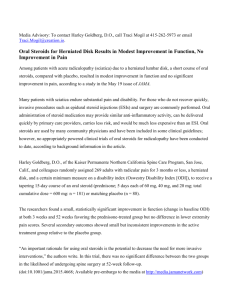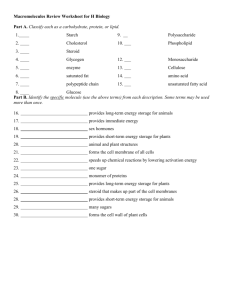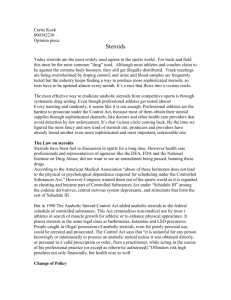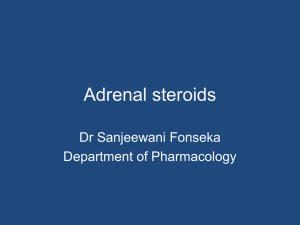The Science of Steroids
advertisement
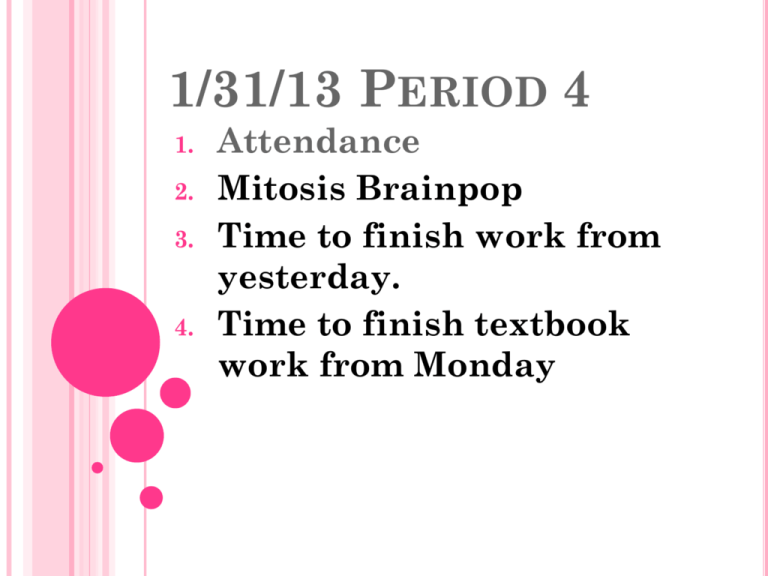
1/31/13 PERIOD 4 1. 2. 3. 4. Attendance Mitosis Brainpop Time to finish work from yesterday. Time to finish textbook work from Monday STEPS TO MAKING A CHEWING GUM NEURON: 1. 2. 3. Chew your gum. Fold a piece of wax paper so it looks like a book. On the inside of the book – use your chewed gum to make a neuron. a. b. c. d. e. f. g. Stretch it out to make axon (globs on both ends) Make cell body from the bigger glob Make dendrites from the cell body Make terminal branches from the smaller blob. The very tips of these will be the axon terminals. Put the pea in the middle of the cell body to be the nucleus. Put rice spaced out on the axon to be the myelin sheaths. The spaces in between the rice will be the Nodes of Ranvier. 4. Fold over the wax paper to close the book. Press down lightly. 5. Cut the wax paper around your neuron. 6. Cut out an interesting pattern of green papers to act as a frame to go under your wax paper. 7. Glue all to a regular piece of copy paper. 8. Use the little sticky dots to label the eight parts. 9. Make a key of the dot numbers and names. Include the function of each part too. 10. Look over the grading rubric to make sure that you will get maximum credit for this lab! Staple everything together – including rubric and turn it in! You will need: gum, paper clip, wax paper, five grains of rice, one pea, sticky label dots, glue WHAT PARTS DO YOU KNOW THAT ARE IN THE NERVOUS SYSTEM? Brain • Spinal Cord • Peripheral Nerves http://outreach.mcb.harvard.edu/materia ls.htm http://outreach.mcb.harvard.edu/materia ls.htm WHAT MAKES UP THE BRAIN, THE SPINAL CORD OR YOUR PERIPHERAL NERVES? Neurons are “the cell” Cell body Nucleus Axon Dendrite What do you think surrounds the cell? What other organelles would be needed? QuickTime™ and a TIFF (Uncompressed) decompressor are needed to see this picture. QuickTime™ and a TIFF (Uncompressed) decompressor are needed to see this picture. http://outreach.mcb.harvard.edu/materia ls.htm http://outreach.mcb.harvard.edu/materia ls.htm HOW ARE NEURONS CONNECTED? Synapses!! WHY ARE NEURONS CONNECTED? MORE NEURON CONNECTIONS! Close up look at your synapse AXON What is this in the membrane? The synapse where the action happens The next cell’s plasma membrane Transport protein HOW DOES THE SYNAPSE CARRY THE SIGNAL? 1.Electrical current travels down the axon 2.Vesicles with chemicals move toward the membrane what is that called? 3.Chemicals are released and diffuse toward the next cell’s plasma membrane 4.The chemicals open up the transport proteins and allow the signal to pass to the next cell - what type of diffusion is this? http://outreach.mcb.harvard.edu/materia ls.htm The synapse carries a signal from cell http://outreach.mcb.harvard.edu/materia to cell ls.htm 1 2 3 4 THERE ARE LOTS OF PROTEINS AND CHEMICALS IN YOUR BODY TO DO THE WORK Why is it important that it is an electrical current? http://outreach.mcb.harvard.edu/materia ls.htm http://outreach.mcb.harvard.edu/materia ls.htm ARE ALL NEURONS EQUAL IN SIZE? Brain vs spinal cord vs peripheral nerves? About how many neurons are in the human brain? 100 billion About how many neurons are in the spinal cord? 1 billion How long do you think the longest axon in the world is? around 15 feet How many synapses are in one neuron? 1,000 to 10,000!! http://outreach.mcb.harvard.edu/materia ls.htm THIS SCIENCE IS CALLED N EUROBIOLOGY Looking at the actual cells - how do they work? Looking at the connections - how and when do they work? Looking at what can change normal cells and connections Looking at diseases that occur in the brain One of the largest areas still unknown The you that is you is because of your neurons connecting! http://outreach.mcb.harvard.edu/materia ls.htm http://outreach.mcb.harvard.edu/materia ls.htm WHAT DO YOU THINK CAN CHANGE NEURONS AND THEIR CONNECTIONS? Accidents Drugs Alcohol Disease http://outreach.mcb.harvard.edu/materia ls.htm ACCIDENTS Physical injury of your neurons Drugs and alcohol bind important receptors on http://outreach.mcb.harvard.edu/materia neurons ls.htm Repeated binding causes the neuron to die http://outreach.mcb.harvard.edu/materials.htm http://outreach.mcb.harvard.edu/materia ls.htm DRUGS = NEURON DEATH http://outreach.mcb.harvard.edu/materia ls.htm ALCOHOL DAMAGES DENDRITES - CAN REPAIR AFTER ABSTINENCE http://outreach.mcb.harvard.edu/materia ls.htm Alcohol blocks receptors and slows down transmission •Parkinson's Disease •ALS - Lou Gehrig’s Disease •Huntington’s Disease •Multiple Sclerosis •Alzheimer's •Cerebral Palsy •Epilepsy •? SIDS http://outreach.mcb.harvard.edu/materia ls.htm 100 Billion or so neurons - what’s the problem with some of them dying? •Does everyone react the same way to accidents, or drugs and alcohol? •Do all organisms react the same to all stimulus? •Cells multiply all the time - will your neurons? •Which of your activities use your neurons? http://outreach.mcb.harvard.edu/materia ls.htm What if neurons die here? or here or here http://outreach.mcb.harvard.edu/materia ls.htm or here or here Thinking About… …Doping for Gold a video about the beginning of organized doping in international athletic competition Let’s Divide Our Thinking Into: The Science of Steroids The Influence of a Society on Steroid Use In the GDR in the 1960s – 1980s In international competition today So…Is Steroid Use Good or Bad? Let’s take a look at what steroids can actually do! The Science of Steroids Question: What effects can testosterone - based steroids have on the human body? She’s a lovely lass. But are you a little afraid to bring her home to meet Mom? Concepts of beauty are often cultural. Body builders have their own culture. What are your views of symmetry and strength in the human body? Most Steroid Users Don’t Look as Extreme as the Previous Two Photos! Max Jaben, an American on the Israeli Olympic Swim Team in 2008 is shown here. He tested positive for the anabolic steroid called boldenone in July 2008. He was banned from the August 2008 Olympics in July 2008. The ban was for 2 years. columbiamissourian.com Numerous countries had top athletes banned from the 2008 Games because they tested positive for steroids. The Science of Steroids How do steroids produce these changes? Well…the story starts with the membrane of the nucleus that guards against uninvited visitors to that precious prisoner of the nucleus, the DNA. Except for… …the fact that steroids have a “special pass.” Once a steroid gets into the cell, it picks up its pass, and gets carried right into the nucleus! The special pass is called the hormone receptor. The receptionist says “The doctor will see you now!” So what does the hormone receptor “say”? “The nucleus will see you now!” And what language is the steroid and the hormone receptor speaking? Of course, it’s the language of the body… Shape! Let’s visualize this – is your pen ready to jot some info on this shape conversation? Outside of cell Steroid Inside of cell 1 Cell membrane 2 Nuclear membrane 4 Steroid receptor 5 6 3 New protein synthesized How do anabolic steroids work? Let’s break it down in order 1 ____________is outside the_______. 2 Steroid ________across ______________ 3 Steroid binds to the “pass,” the ____________ ___________. Together they are the hormone receptor complex (HRC). The ______ enters the__________________. 4 _____binds with_____. This activates a section of DNA. 5 DNA _________________ for making a _____________are carried out of the____________. 6 __________molecules are made and _____________ increases. The Science of Steroids What Effects Do Steroids Have? They increase protein synthesis in cells, so cells make more tissue This process of cell tissue building is called anabolism; the drugs are often called anabolic steroids Muscle tissue breaks down more slowly Cells differentiate more easily into muscle cells instead of fat cells Additional Positive Effects of Anabolic Steroids These can be used for good medical purposes: Increase muscle tissue healing Increase appetite Increase bone growth Stimulate delayed puberty But Negative Side Effects Can Occur Influence masculine traits such as hair growth, vocal cord development in women Influence hair loss and low sperm count in men Can have negative effects on liver tissue, reproductive tissue and heart muscle Increase competitiveness and aggressiveness because anabolic steroids affect the limbic system of the brain The Science of Steroids Let’s Recap: The Science of Steroids What special ability do anabolic steroids have in the cell? They pick up a “pass” to enter the nucleus. What is the term for the “pass?” Hormone receptor Once in the nucleus, then what? The HRC activates a section of DNA to give directions What directions from the DNA does the steroid activate? Make more tissue! Where is this tissue actually made? At the organelles called ribosomes in the cell cytoplasm. The Science of Steroids What is an anabolic steroid? A type of steroid that produces tissue growth Are all steroids anabolic? No. Some steroids reduce swelling and don’t cause tissue growth. This type is called a cortico-steroid. They are not likely to be abused because they don’t cause tissue building. Switch Gears Now! What is the effect of a society on steroid use? The Influence of a Society on Steroid Use The Geography of the GDR http://www.memorial-caen.fr/10event/gb/ciel_tex21.htm The GDR (German Democratic Republic), known as East Germany was smaller than the FRG (Federal Republic of Germany), or West Germany. What countries border the GDR? Those countries were under the control of the Soviet Union The Influence of a Society on Steroid Use W H Y ? france24.com all-athletics.com Heidi Kreiger Andreas Kreiger Heidi Kreiger The Influence of a Society on Steroid Use http://kristinbjorg.blogcentral.is/ beijing-olympics2k8.blogspot.com http://transgriot.blogspot.com/2008/07/how-blue-pills-turned-heidikrieger.html Happier Times Now The human spirit, like the human body, has tremendous abilities to heal after traumatic stress. The Influence of a Society on Steroid Use The GDR wanted to use successful sports programs to cheer up a depressed nation. What happened to the chosen children and young adults? How did the athletes get the steroids? Did they know they were receiving steroids? How did steroids affect their training At first? Later? The Influence of a Society on Steroid Use If you were one of the athletes, how do you think you would have reacted to your suspicions that you were getting more than vitamins? What would have been the pressures on you in your decisions? What would have happened to you? How would you feel about your medals? Decades later: the former chief doctor of East Germany's swimming team was convicted of giving performance-enhancing drugs to young athletes without telling them. Lothar Kipke, 72, was fined 7,500 German marks ($3,900) and given a 15-month suspended jail sentence. news.bbc.co.uk He was convicted on more than 50 charges of causing bodily harm by giving them steroids. The Influence of a Society on Steroid Use 1. Judge Peter Faust said Kipke had played a key role in the East German system to give swimmers steroids in order to boost their performance, and that he knew the drugs “harmful side effects.” 2. The doctor admitted that he had provided the drugs - a widespread practice in communist East German sport - but he said that in the 1970s little was known about their potential side-effects. 3. Prosecutors said that neither the swimmers nor their parents were told about the drugs and were therefore unaware that they might suffer side-effects. 4. The women involved in the case are now suffering from such problems as disturbed muscle growth, excessive body hair and a deepened voice. Two former East German swimming champions blame their babies' disabilities on the steroids. One has a daughter who was born blind, the other a son with a club foot. They say Dr Kipke continued to give them drugs despite knowing the potential consequences (Lothar Kipke, 72, was fined 7,500 German marks ($3,900) and given a 15-month suspended jail sentence.) The Influence of a Society on Steroid Use Our Hero:Tessa Sanderson of England Won the Gold, finally, in 1984! Steadfastly refused to use steroids throughout her career. Prevailed over East German Ruth Fuchs, her long-time steroid-using nemesis who had beaten her many times. Photo: GETTY IMAGES Bournelocal.co.uk.com. 08/11/11 What were the influences on Tessa Sanderson to NOT take steroids? She competed internationally at a time when steroids were being taken by her competitors This included GDR athlete Ruth Fuchs who beat her many times! (Ruth Fuchs was given steroids and by the 1970s steroid use was suspected of the East Germans by other countries) Why do you think she resisted taking steroids? How do you think you would have responded if you were in her shoes? Science doesn’t have its own independent values of good or bad, right or wrong, righteousness or evilness. These are values placed on the use of science by a society through its laws, or by individuals in the society, sometimes in opposition to current laws. In the GDR, the government thought that people didn’t need to know about steroids, they just needed to perform. In our society, anabolic steroid use by athletes is illegal. Why? Is this fair or unfair? Should athletes be legally allowed to take risks with their health? If everyone KNEW who was taking steroids would that affect competition? Would it make athletes less likely to abuse steroids or more likely? What do you think? Should steroid use by athletes be illegal or legal? The Endocrine system Glands and hormones Hormones- chemical messengers carried by blood May stimulate other glands Regulate growth, development, metabolism, sex processes Hormones need a specific receptor on a specific cell to do their job Major Glands of the Endocrine system Pituitary Thyroid Parathyroid Adrenal. Pancreas Ovaries Testes Pituitary gland Master gland of body Located in the depression of sphenoid bone Produces many hormones that affect other glands thyroid stimulating hormone Somatotropin- growth hormone Lutenizing (LH)- causes ovulation ICSH- causes testes to secrete testosterone Melanocyte stimulating- distribution of melanin in skin ADH- antidiuretic hormone Giantism- oversecretion of somatotropin before puberty Dwarfism- undersecretion of somatotropin. Cause: tumor, injury, infection, genetics Diabetes insipidus- decreased ADH Thyroid- produces hormones that control metabolism and calcium in blood. Thyroid gland must have any source of iodine goiter- not enough iodine hyperthyroidism hypothyroidism Adrenal glands Located just above the kidney Secretes many hormones Epinephrine Norepinephrine Many steroid hormones, inc estrogen and androgens. Pancreas pancreatic juices into the intestine secretes insulin, a hormone that transports glucose into cells. Also secretes glucagonincreases glucose in bloodstream Diabetes Mellitus Cause- decreased secretion of insulin Symptoms Excessive thirst, excessive urination, hyperglycemia, slow healing of skin infections Affects 21 million in US: 7% of population Estimated 1/3 of people who have diabetes don’t know it 225,000 die each year 132 billion/year- 10% of our health care spending Insulin was the first hormone identified (late 1920's) which won the doctor and medical student who discovered it the Nobel Prize (Banting and Best) 1982 - Human Insulin - First ever approved genetically engineered human therapeutic by Genentech The Human Reproductive System Male Reproductive System urinary bladder seminal vesicles prostate gland urethra penis rectum epididymis Cowper’s gland testis/testes scrotum vas deferens Male Reproductive System (frontal view) See p. 62 in Review book Male Reproductive System 1. 2. Scrotum – sac of skin that holds testes. Hangs below body to keep testes cool. Sperm cannot be produced if body is too warm. Testes move into scrotum just before birth. Testis/testes – male gonads. Made up of small, coiled tubes – seminiferous tubules. 300-600 per testis. Immature sperm made here. Secrete testosterone Male Reproductive System 3. 4. 5. Epididymis – storage area in upper rear of testis. Immature sperm move here to mature – takes 18 hours. Vas deferens – tube that leads upwards from each testis into lower part of abdomen from epididymis. Cowper’s gland – produces fluids that nourish sperm and protect them from the acidity of female. Combination of sperm and fluids - semen Male Reproductive System 6. Rectum – holds wastes 7. Seminal vesicles – same job as Cowper’s gland 8. Urinary bladder – stores urine 9. Prostate gland – same job as Cowper’s gland and seminal vesicles 10. Urethra – passageway for excretion of urine and for sperm to leave body. Vas deferens empties into urethra Male Reproductive System 11. Penis – male reproductive organ. Facilitates internal fertilization Ejaculation – muscular contractions force semen through urethra. Before, during and after ejaculation reflex actions keep outlet of bladder closed Hormones and Negative Feedback in Males Negative Feedback – change that leads to a response that causes something to counteract that change Luteinizing Hormone (LH) – stimulates testes to produce testosterone Testosterone – stimulates development of sperm. Once there is a large number of sperm, puberty is complete. Hormone Negative Feedback System What is the effect of high levels of LH? Testosterone is produced What is the effect of high levels of testosterone? Slows production of LH which in turn slows production of testosterone What is the overall outcome of this on-off negative feedback system involving LH and testosterone? Nearly constant level of both hormones - homeostasis Another Way of Looking at Negative Feedback in the Male Reproductive System Brain Pituitary gland Male Reproductive Organs target cells – receptor cells LH stimulates the testes cells Male Reproductive System and Hormones 1. 2. 3. Explain how LH stimulates the testes to produce testosterone. Circulates in the blood- reaches the testes target cells – stimulates them to produce testosterone What happens when the levels of testosterone are too high in the body? LH level drops What is negative feedback and how does it maintain homeostasis? Change in conditions triggers response in body to counteract that condition. Keeps hormones in balance Female Reproductive System oviduct ovary Urinary bladder uterus urethra vagina cervix rectum Female Reproductive System (frontal view) See p. 61 in Review book Female Reproductive System 1. Ovary – female gonads. Secrete estrogen – produces secondary characteristics, menstrual cycle Produces eggs – 2 ovaries 4cms long, 2 cms wide Follicles – each ovary contains 200,000 egg sacs called follicles. In each follicle is an immature egg. All the eggs are present at birth. During the woman’s lifetime 500 eggs mature When an egg matures, follicle moves to surface of ovary. Follicle breaks & releases the egg – ovulation Egg can be fertilized for about 24 hours after ovulation Female Reproductive System 2. Oviduct (fallopian tube) – Each ovary is near but not connected to oviduct. Tube with funnel-like opening. Cilia line it to create a current that draws the egg into the tube. Egg is fertilized in the oviduct 3. Uterus – thick, muscular, pear-shaped organ. Once egg is fertilized it finishes its development in uterus attached to uterine wall Female Reproductive System 4. Urinary bladder – storage of urine 5. Urethra – passage of urine to outside of body 6. Vagina (birth canal) – leads to outside of body 7. Cervix – narrow neck of uterus 8. Rectum – passage for wastes The Menstrual Cycle What is the menstrual cycle? Cycle during which an egg develops and is released from the ovary and the uterus is prepared to receive a fertilized egg Menarche: first menstrual period – usually occurs between 11 and 12 Menopause: time when a woman stops menstruating, usually between 45 & 55 and is no longer able to conceive. The Menstrual Cycle The Menstrual Cycle 1. Menstruation: Loss of egg and uterine tissue via vagina if fertilization does not occur 2. Follicle Stage (follicular stage): lasts 10 days, FSH & LH levels increase, egg matures, follicle secretes estrogen to prepare uterus The Menstrual Cycle 3. Ovulation: High level of estrogen detected by hypothalamus, increased LH, decreased FSH, follicle bursts – egg released 4. Corpus Luteum Stage (Luteal Phase): LH converts follicle to corpus luteum – secretes estrogen & progesterone. Progesterone prepares uterus. Increased progesterone keeps LH & FSH low Another Way of Looking at Negative Feedback in the Female Reproductive System (Hormones of the Menstrual Cycle) Brain Pituitary gland FSH (causes egg to mature in follicle) LH (causes to egg to be let go = ovulation) ovary uterus Estrogen (causes uterine lining to thicken & build up to prepare for egg) Progesterone (helps maintain uterine lining) Hormones of Menstrual Cycle What happens if fertilization occurs? Corpus luteum keeps producing progesterone to maintain pregnancy. After 5 weeks the embryo produces progesterone – this inhibits LH & FSH so no menstrual cycle What happens if fertilization does not occur? There is no implantation – the corpus luteum breaks down. Progesterone level drops, uterine lining breaks down – menstruation. FSH & LH are produced again – new cycle Average Menstrual Cycle is 28 days long Ovulation to Implantation oviduct uterus cervix vagina egg from ruptured follicle ovary sperm follicle Ovulation to Implantation 1. 2. 3. Ovary – produces estrogen & progesterone – meiosis occurs & egg develops Egg matures in follicle of ovary Ovulation – egg released from follicle – may live for 24 hours - egg moves into fallopian tube by cilia Ovulation to Implantation 4. Events in fallopian tube a. b. Fertilization occurs here. Sperm lives 4-5 days (egg lives 1 day) Zygote undergoes mitosis & travels down fallopian tube within 6-10 days. Zygote is ready to implant into uterus. Ovulation to Implantation 5. Events in uterus a. b. Implantation – embryo implants/embeds into uterine lining & secretes hormone HCG to signal its arrival Cell Differentiation – cells divide by mitosis & become different due to gene expression. Different embryo parts will form. Menstrual Cycle Animation
